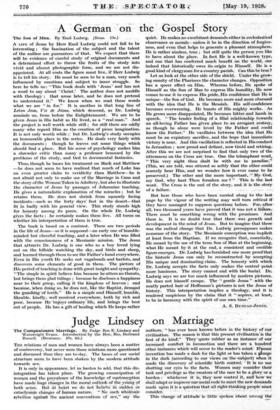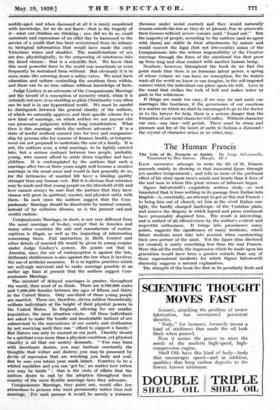Judge Lindsey on Marriage The Companionate Marriage. . . By Judge Ben
E. Lindiey and Wainwright Evans. Introduction by the Ron. Mrs. Bertrand
Russell. (Brentano. 10s. 6d.)
TEE relations of men and women have always been a matter of controversy, but never were those relations more, questioned and discussed than they are to-day. The bases of our social structure seem, to have been shaken by the modern attitude towards sex.
It is only in appearance, let us hasten to add, that this dis- integration has taken place. The growing emancipation of women and the nrgyalence of the knowledge. of contraception have made huge changes in the moral outlook of the young of both seies-. Bait at heirt we dd not -believe' ill Sildden or eataelYsinic changes of human nature. " No such Wholesale rebellion against the ancient conventions of sex," say the authors, " has ever been known before in the histOrY of our civilization. - The reason is that this present civilizatiodis the first of its kind." They 'quote rubber as an instance of our increased comfort in locomotion and there are a hundred other instances which-will occur to the reader's mind. Nyman invention has made a dash for the light or has taken a plunge in the dark (according to our views on 'the -subject) when it made the discoVery of scientific birth control. It is no use shutting Our eyes to the facts. Women may consider their task and privilege as the creators of the race to be a glory or burden : - -Whichever it is, they now control it, and' how we shall adapt or improve oursocial code to meet the new demands made upon it is a question that all right-thinking people niust This 'change 'of attitude' is -little spoken about among the middle-aged, and when discussed at all it is rarely, considered with knowledge, for we do not know—that is the tragedy of it—what our children are thinking ; nor, did we do so, could restraints and repressions of an elder day be harnessed to the service of a youth that his been accustomed from its infancy to biological information that would have made the early Victorians wince and shudder. = the manifestations of sex are due, physiologically, to the outpOuring of substances into the blood stream : that is a scientific fact. We know that this most powerful force in the world can sometimes or even frequently be restrained from:witliout: But obviously it is in some:sense like screwing down a safety-valve.- We must ha* education and culture controlling the emotions from within,
and there can be no true culture without knowledge of facts. . - Judge Lindsey is an advocate of the-Companionate Marriage and the herald of a conception of morality- which; while it is certainly notnew, is-as startling as-plain Christianity verY often can be and is- in our hypocritical wcirld. We Must be careful to distinguish between the general CharitY of the authors, of which- vie naturally approve, and their specific scheme for a new kind of marriage, on which neither we nor anyone else can pronounce judgment without long consideration. What then is this marriage 'which the authors advocate ? - It is a state of lawful wedlock entered into for love and companion-
ship by- persons who for of finance, health, or tempera- ment are not prepared to 'undertake the'eare of a family. It is not. the authors' aver, a trial marriage, to be lightly entered into, 'but-a serious contract between two people, probably young, who cannot afford .to settle down together and have children: It is contemplated by the authors that such a niarriage after two or three years might well become a creative marriage in the usual sense and would in fact generally do so, for- the intimacies of married -life - Have' a binding quality strongerthan any human vow: But it is Obvious that mistakes may be Made and that young people on the threshold oflife and love cannot always be sure that the partner that they • have chosen will grow in spiritual; mental, and physical unity with them,s An such cases the authors suggest that the Com- panionat,e, Marriage should-be dissolvable by- mutual consent, instead • of by collusive divorce, as is the present 'sad and
sordid custom:. . „ . .
ComPanionate -Marriage,' in short, is not very different from the tisual marriage of 16-day, except that in America and many -other 'countries the sale-arid manufacture of contra- ceptives is illegal, as well as -the iniparting of information concerning them. Full instruction in Birth COntrol and other details of married life would be given to young couples under 'Judge Lindsey's system. He points out that in America; since the use of contraception is against the law, deliberate childlessness isalso against the law when it involves the use of artificial measures. It is to legalize practices which are wellnigh universal and to make marriage possible at an earlier age than at present that the authors suggest Com-
panionate Marriage: '
The mischief :of delayed marriages is greater, throughout the world, than most of us think. There are 9,760,000 males and 7,688,000 .fetrialeS between the 'ages of fifteen and thirty in the United- gatei:- Only one-third of these young people are married. There are, therefore, eleven million theoretically celibate individuals at the height of their physical powers in the United 'States. In England, allowing for our smaller Population, the same Situation exists. All these individuals are asked to Mike the terrific and incalculable instinct of sex subservient to the convenience 'of our society and civilization by not marrying until they can " afford to support a family." But Nature can Only be coerced ut our peril. Chastity should be a spiritual even more than a physical condition, yet physical chastity is all that our society demands. " You may burn with inordinate. desires, you may harbour. constantly the thoughts that wither and destroy, you may be possessed by devils of repression that are wrecking you body and soul. But be sure you retain your, mask intact. Contrive to be a. whited sepulchre and you can `get by,' po matter how rotten you may be . inside " that is the state of affairs that the. authors desire to end . by , the adoption throughout their country of the more flexible marriage laws they advocate.
Companionate Marriage, they. point out, would offer few attractions to persons who want promiscuity rather than real
marriage, ,Fai such persons it .would merely a nuisance
(because under social control) and they would naturally remain outside the law as they do at present, free to prosecute their liaisons without severe censure until " found out." But the majority of people, according to the authors (and we agree with them) are. stable in their attachments by nature and would convert the legal (but not irrevocable) union of the Companionate into the serious responsibility of the Creative marriage through the force of the emotional ties that grow up from long and close contact with another human being.
Nowhere, however, throughout the book do we find the point made that there_ is an immense latent power, a spring of whose volume we can have no conception, for its waters wash all the world we know or can imagine, in the self-imposed control which the individual can place upon his will. Love is the wand that strikes the rock of Self and makes water to gush in the wilderness.
If things are made too easy, if we may tie and untie our marriages like bootlaces, if the governance of our emotions is a matter on which we shall be encouraged to go to the doctor or to the lawyer for help, there is a serious danger that the formation of our racial character will suffer. Without character our race—any race—will perish. There must- be stress and pressure and fire at the heart of earth to fashion a diamond ! the crystal of character arises in no other.way.



































 Previous page
Previous page